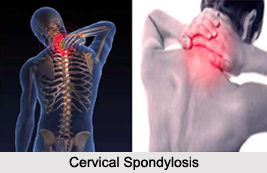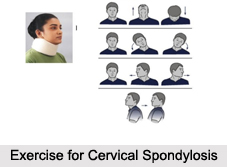 Cervical Spondylosis is also called "Cervical Osteoarthritis" and is a disorder of cervical vertebrae. It is often the result of degenerative disk disease and it occurs when one vertebra slips slightly forward over another vertebra. It is a condition wherein the vertebral column is compressed and the flow of energy gets restricted in the nerves at the cervical or the neck region, which later penetrates in the lower areas of the body causing pain and discomfort. The displaced bone may pinch the sciatic nerve where it leaves the spine. This is one of the most common ailments. Cervical Spondylosis usually occurs in middle-aged and elderly people.
Cervical Spondylosis is also called "Cervical Osteoarthritis" and is a disorder of cervical vertebrae. It is often the result of degenerative disk disease and it occurs when one vertebra slips slightly forward over another vertebra. It is a condition wherein the vertebral column is compressed and the flow of energy gets restricted in the nerves at the cervical or the neck region, which later penetrates in the lower areas of the body causing pain and discomfort. The displaced bone may pinch the sciatic nerve where it leaves the spine. This is one of the most common ailments. Cervical Spondylosis usually occurs in middle-aged and elderly people.
The cervical (neck) spine is made up of small circular bones, seven cervical vertebrae. These vertebrae are arranged one over another, having a particular gap between each of them. In some conditions like ageing, injuries, any disease related to bones and in the condition of wear or growing of bones the distance or gap between these vertebrae becomes abnormal. Consequently the nerves passing, through that region get pressurized, giving rise to the symptoms of this disease.
Causes of Cervical Spondylosis
Cervical Spondylosis is caused by numerous reasons. The factors, which cause these painful conditions, include wrong standing or sitting posture, sudden pulling of a heavy weight especially after a long period of rest and injury to the spine as well as cancer. Working continuously in tense atmosphere also produces this condition.
Symptoms of Cervical Spondylosis
The common symptoms of Cervical Spondylosis are linked with pain and stiffness in the affected region, with such symptoms in the upper limbs, inability to bend and move properly is also experienced. Other symptoms in this case include tingling sensation in the arms and fingers. There are added symptoms of Cervical Spondylosis too, that consists of pain and heaviness in the neck and stiffness while moving the neck.
Exercise for Cervical Spondylosis
For Cervical Spondylosis, one can do exercises and stretches that focus on keeping the neck mobile. These exercises in general help to build strength, flexibility and increase range of motion.
Treatment of Cervical Spondylosis
Cervical Spondylosis tends to be a chronic condition. This can be treated by conventional medicine and also by using alternative medicine. Surgery is required only in rare cases. The goal of surgery is to remove the source of pressure on the spinal cord and nerves. The routine treatment for Cervical Spondylosis involves the wearing of closely fitted neck collars.
The physiotherapy methods can also be used to treat Cervical Spondylosis. The process involves using of radiant heat, short-wave diathermy, massage, traction and exercise along with the use of a proper mattress and pillow. However, these do not always relieve the painful symptoms and are short-lived measures.
Furthermore, nature care can cure Cervical Spondylosis too. Water Treatments is a process that is involved as a nature cure treatment. Magnetic Therapy also plays a vital role in curing Cervical Spondylosis.




